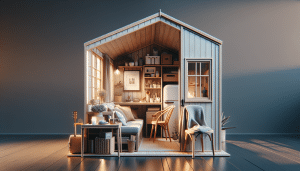Why Minimalist Living Might Change How You View Home
Lily Carter November 16, 2025
Explore why minimalist living continues to captivate so many seeking simplicity, mental clarity, and more sustainable lifestyle choices. This guide looks at how decluttering, mindful consumption, and design trends can reshape your experience of daily life and entertainment.
What Is Minimalist Living and Why Are People Choosing It?
Minimalist living stands out in today’s world where possessions often fill every available space. Rooted in the principle that less can truly be more, this lifestyle encourages people to keep only what truly matters. The main draw lies in the promise of reduced stress and increased clarity, especially as modern routines become more chaotic. Minimalist living asks: which items truly bring value? This approach sees people editing their homes and lives, resulting in cleaner spaces and calmer minds. As a concept, minimalist living aligns closely with sustainable practices, attracting those who want to tread lightly on the planet or escape the pressures of consumer culture. Recent pop culture influences, including design shows and social media influencers, have only accelerated its popularity, making this lifestyle more accessible and appealing to a broader audience.
Supporters of minimalism often report increased productivity and creativity as a result of cleaner, simpler environments. With fewer distractions, there’s often more space to focus on what really matters. A decluttered home can contribute to a sense of accomplishment and bring about daily satisfaction. This shift towards intentional living also encourages making smarter, longer-lasting purchases, benefiting both the environment and personal finances. As people become more aware of the emotional and financial costs of excess, the minimalist approach serves as a practical solution to tackle the urge for constant accumulation. Interestingly, even the entertainment industry reflects this movement, with films and TV series highlighting the journey toward less. Minimalist living offers a fresh perspective, allowing individuals to express themselves while paring down to what’s essential.
Some people take inspiration from Japanese Zen traditions, which emphasize harmony, mindfulness, and purpose in everyday objects. The rise of minimalist architecture and design also demonstrates how a clutter-free environment doesn’t mean sacrificing beauty. Instead, each piece in a minimalist home serves a distinct purpose, often enhancing the space’s tranquility. There’s growing interest in ‘tiny house’ living and capsule wardrobes, each representing a slice of the minimalist philosophy. Whether it’s downsizing to a smaller home or simply adopting a decluttering routine, minimalist living can transform not just physical spaces but also the experience of daily life. The beauty of this approach is its flexibility. Individuals can adopt minimalist living practices at their own pace and according to their needs.
How Minimalist Design Shapes Modern Home Trends
Minimalism extends far beyond organizing drawers or closets. It has rooted itself in interior design, shaping how modern homes are planned, decorated, and experienced. Sleek furniture, open spaces, and neutral color palettes often form the backbone of minimalist home design. The principle is simple: every element should have a clear function and a place, promoting both utility and beauty. This approach has led to the emergence of multipurpose furniture, streamlined storage solutions, and calm, light-filled rooms that maximize both style and flow.
Architects and designers increasingly favor clean lines and uncluttered aesthetics because they help reduce visual chaos. Materials like natural wood, bamboo, and glass are common in these environments, as they add warmth and character without overwhelming the senses. Minimalist design also complements the shift toward eco-friendly living, as it encourages the use of sustainable, locally sourced materials. This trend not only supports environmental responsibility but also results in personalized spaces that reflect the inhabitant’s tastes and values with fewer, higher-quality items.
Smart home technology is finding new life in minimalist spaces as well. Devices are built to be discreet or seamlessly integrated into walls and furniture, providing convenience without clutter. This synergy between minimalism and technology has contributed to the popularity of open concept homes. The emphasis remains on flexibility, adaptability, and the idea that less visual noise makes for a more enjoyable, relaxing home. As interest in minimalist design grows, more people find themselves rethinking traditional approaches to decorating, ultimately discovering that simplicity can be the new trend-setting statement.
Decluttering and Mindful Consumption for Everyday Life
Decluttering is the first step many take toward minimalist living. It doesn’t have to be overwhelming or drastic. Instead, the process becomes a thoughtful journey through one’s possessions, assessing which items hold real importance. Tools like the “one in, one out” rule or the popular KonMari Method encourage mindful choices every time something new is brought home. Over time, these habits become second nature, helping individuals maintain a cleaner and more peaceful living space. The benefits extend to reduced daily maintenance and more free time.
Mindful consumption is a key facet of the minimalist ethos. Rather than focusing on acquiring more, the focus shifts to meaningful acquisitions. This can mean investing in fewer, longer-lasting goods or supporting local artisans and sustainable brands. With rising awareness around issues like fast fashion, single-use plastics, and environmental impact, more people are taking an interest in minimalist lifestyles as a way to cut waste. Engaging with this mindset can lead to more deliberate habits in shopping, media consumption, and even online subscriptions, resulting in a more meaningful life experience.
The act of letting go can also be deeply emotional. Every item in a person’s home often comes with memories. Minimalist advocates emphasize honoring those memories but ultimately striving for environments that bring peace, not overwhelm. Many discover that decluttering has ripple effects – less clutter means less time cleaning, and more time to enjoy hobbies or relaxation. Over time, these efforts foster mindfulness and gratitude for what remains. Mindful consumption and regular decluttering together act as ongoing reminders to value experiences over possessions.
Minimalist Living and Its Impact on Wellbeing
There’s growing evidence that minimalist living can support emotional and mental wellbeing. Living in a cluttered environment is often linked with increased stress and anxiety, while cleaner, organized spaces are found to promote calmness and focus. Minimalist living principles encourage individuals to be intentional not only with their things but also with their schedules and relationships. This can mean saying “no” more often, making time for meaningful moments, and carving out space for relaxation or creativity.
The wellness connection doesn’t stop at mental health. People adopting minimalist habits often report improved sleep, healthier eating, and increased motivation to engage in physical activity. By removing physical and digital distractions, there’s more opportunity to prepare healthy meals, enjoy outdoor spaces, or simply rest more soundly. This positive cycle reinforces itself the longer these habits are in place. Studies also highlight that intentionally designed homes can have lasting effects on happiness and satisfaction, acting as sanctuaries from the busyness of everyday life.
Surprisingly, minimalist living can also encourage social connection. By freeing up time usually spent managing excessive belongings, there’s more room for hosting friends or community involvement. Without material distractions, relationships can take center stage. Many community groups and online forums provide support and tips for those transitioning to minimalist lifestyles, creating a sense of collective wellbeing. Ultimately, minimalism is less about deprivation and more about focusing on what brings fulfillment and joy.
Minimalism in Entertainment and Media Consumption
Entertainment choices are increasingly being viewed through a minimalist lens. With streaming services offering endless options, many people adopt intentional viewing and listening habits. Creating curated playlists, choosing shows that add value, or dedicating specific times for digital detoxes can all reduce overwhelm. This mindful approach helps fight decision fatigue, making media consumption more enjoyable and meaningful.
Minimalist living can inspire people to seek experiences over possessions. Attending community events, live performances, or group workshops often brings greater joy and longer-lasting memories than passive screen time. In fact, many find that reducing time with digital content allows for the rediscovery of activities like reading, crafting, or outdoor hobbies. These pursuits can provide both relaxation and creative fulfillment in line with minimalist values.
Digital minimalism is now its own movement, encouraging practical steps such as decluttering devices, unsubscribing from unused apps, or organizing photo libraries. As with tangible spaces, less digital clutter results in more mental clarity and less stress. Embracing minimalist digital habits is another way to align entertainment and daily routines with a broader lifestyle committed to balance and intentionality. This harmony can profoundly impact overall life satisfaction.
How to Start Incorporating Minimalist Living Into Daily Routine
Starting a minimalist journey begins with small, consistent steps. For most, beginning with a single room – often the bedroom or kitchen – is manageable. Taking time to identify which items are cherished or essential ensures the process is personal and meaningful. Routines like weekly decluttering or setting a limit for new purchases can help reinforce minimalist habits without feeling restrictive.
Setting realistic expectations is crucial. Minimalism isn’t a one-size-fits-all solution or an overnight transformation. Each person can adopt what suits their lifestyle best. Continuing to research minimalist tips, joining online communities, and documenting progress are popular ways to stay motivated. Many find support in sharing before-and-after stories or seeking inspiration from minimalist blogs and videos. These practices create accountability and a source of encouragement through every phase of the journey.
Remember, minimalist living should not be about perfection but about progress. Flexible goals help prevent discouragement and allow individuals to appreciate the improvements as they come. Over time, many find that adopting minimalist principles enhances their sense of control, eases stress, and strengthens their appreciation for simple pleasures. No matter where you start, each step toward a simpler life creates new opportunities for contentment and well-being.
References
1. U.S. National Institutes of Health. (n.d.). Mindfulness and Health. Retrieved from https://nccih.nih.gov/health/mindfulness-overview.htm
2. Environmental Protection Agency. (n.d.). Sustainable Materials Management. Retrieved from https://www.epa.gov/smm
3. Mayo Clinic. (n.d.). Stress Management: How to Reduce, Prevent and Cope with Stress. Retrieved from https://www.mayoclinic.org/healthy-lifestyle/stress-management/in-depth/stress-relief/art-20044456
4. U.S. Department of Energy. (n.d.). Energy Efficient Home Design. Retrieved from https://www.energy.gov/energysaver/design/energy-efficient-home-design
5. Harvard Health Publishing. (n.d.). Clearing Clutter for Mental Health. Retrieved from https://www.health.harvard.edu/mind-and-mood/clearing-clutter-for-mental-health
6. American Psychological Association. (n.d.). The powerful mental health benefits of decluttering. Retrieved from https://www.apa.org/topics/mental-health/decluttering







